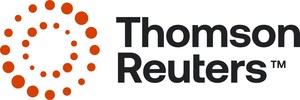Thomson Reuters Study Proposes Solutions to the Economic Risks of Data Overload
Highlights need for "Intelligent Information" to mitigate risks in time-critical decisions
NEW YORK, July 10 /PRNewswire/ -- A new report from Thomson Reuters released today and shared at the Aspen Ideas Festival cites exponential increases in the volume, frequency and variety of data as a critical risk factor in decision-making, especially in time sensitive situations.
The report led by David Craig, Executive Vice President and Chief Strategy Officer and Peter Jackson, Chief Scientist and Vice President, Thomson Reuters Legal, draws on Thomson Reuters research as well as a joint study with Julian Birkinshaw at the London Business School. The study indicates that when faced with unsorted, unverified "raw" data, 60% of decision makers will make "intuitive" decisions that can lead to poor outcomes.
Craig, who is speaking at Aspen today, notes, "The solution to data overload is to provide decision makers with what Thomson Reuters calls Intelligent Information: better organized and structured information, rapidly conveyed to the users preferred device."
Data Overload: The Challenge of Exponential Growth
When data pours in by the millisecond and the mountain of information builds continuously, professionals inevitably cut corners and go with their 'gut' when making decisions that can impact financial markets, medical treatments or any number of time sensitive matters.
To that end, many government regulators have flagged increased financial risk-taking, which can be traced in some degree to imperfectly managed data, as a contributor to the recent financial crisis. Moreover, the world is awash with data -- roughly 800 exabytes -- and the velocity of information is increasing. For example, the Thomson Reuters financial data network, the largest in the world, carries 750,000 updates every second.
The challenge is that the staffing and investment needed to ensure that information and information channels are trusted, reliable and useful is not keeping pace. In fact, it is estimated that the information universe will increase by a factor of 44; the number of managed files by a factor of 67; storage by a factor of 30 but staffing and investment in careful management by a factor of 1.4.
Solution: Satisfying the Users' Hierarchy of Information Needs
Fortunately, as the Thomson Reuters study notes, the same technological revolution that has resulted in the explosion of information also opens the way to new and improved tools for providing intelligent information: better organized and structured information, rapidly conveyed to the user's preferred device.
"The key is to build information systems around the 'Hierarchy of Information Need (HIN)'," notes Peter Jackson. HIN is a concept developed by Thomson Reuters and applied to both information systems and the creation of professional digital technologies.
(Photo: http://photos.prnewswire.com/prnh/20100710/NY33250 )
(Photo: http://www.newscom.com/cgi-bin/prnh/20100710/NY33250 )
- Trusted: The most basic need, trust, is enabled by rapidly aggregating the knowledge of professionals in a relevant space to ensure that data is pre-screened, verified and unbiased. It must also be trusted as secure, given today's cyber-risks.
- Connected: Connections are enabled through technologies such as Thomson Reuters CLEAR Service, which intelligently connects and cross references data across internal and external web channels.
- Contextualized: Professionals can also contextualize information (is it right for my purposes?) through tools that aggregate the behavior of relevant experts/ professionals, extending knowledge to entire communities of users.
While financial markets have gotten the most attention recently, nowhere is the need for context greater than in the legal and regulatory area. This need drove the development of the Thomson Reuters WestlawNext product. This search tool rapidly and intelligently gathers and encapsulates case law and professional opinion from the massive data available across the web at extraordinary speeds.
- Channeled: Once contextual data is fashioned it can be delivered with appropriate speed to people (say every second or half second for a financial trader) or machines (updates in milliseconds).
- Knowledge To Act: After the criteria have been satisfied, a decision maker has more than information. He has actionable knowledge that is trusted, reliable, aligned with his needs and ready to use with a minimal amount of guess work. This frees him up to apply his intuition to his business, as opposed to verifying the quality and nature of information he receives.
"We must use the benefits of the information technology revolution to minimize its risks. This is a joint task that the private sector and governments must closely focus on if we are to avoid systemic crises, in the future, whether we speak of finance, healthcare delivery, international security and a myriad of other areas," comments Craig.
The full report "Intelligence, Intuition and Information" is available at http://thomsonreuters.com/content/corporate/PDF/Intelligence_Intuition_and_Information.pdf.
About Thomson Reuters
Thomson Reuters is the world's leading source of intelligent information for businesses and professionals. We combine industry expertise with innovative technology to deliver critical information to leading decision makers in the financial, legal, tax and accounting, healthcare and science and media markets, powered by the world's most trusted news organization. With headquarters in New York and major operations in London and Eagan, Minnesota, Thomson Reuters employs 55,000 people and operates in over 100 countries. Thomson Reuters shares are listed on the Toronto and New York Stock Exchanges (symbol: TRI). For more information, go to www.thomsonreuters.com.
SOURCE Thomson Reuters
WANT YOUR COMPANY'S NEWS FEATURED ON PRNEWSWIRE.COM?
Newsrooms &
Influencers
Digital Media
Outlets
Journalists
Opted In





Share this article